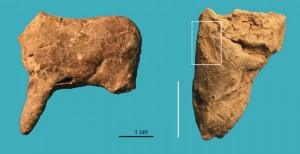Ceramics

Rebecca Farbstein / PLoS ONE. Rights Reserved
A small ceramic figurine depicting a zoomorph was excavated in 2001 from Vela Spila, Croatia. Archaeologists typically associate the origins of ceramic technology with the first pots and vessels made by early sedentary, agricultural societies. However, this figurine was excavated from a horizon with typical late Upper Palaeolithic material culture, radiocarbon dated to c. 15,000 BP. This artefact allows analysis of the origins of ceramic, which appear to have been artistic rather than “utilitarian.” Moreover, it relates to broader issues of innovation, contact and continuity across social and geographic boundaries, and the impact of new materials on artistic expression.
Reading
Farbstein, R., D. Radic, D. Brajkovic, & P. T. Miracle, 2012. First Epigravettian ceramic figurines from Europe (Vela Spila, Croatia). PLoSONE7(7): e41437. Doi: 10.1371/journal.pone.0041437
Vandiver, P., O. Soffer, B. Klima, & J. Svoboda, 1989. The origins of ceramic technology at Dolni Vestonice, Czechoslovakia, Science 246(4933): 1002-1008
